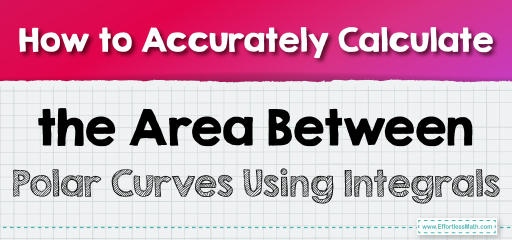How to Accurately Calculate the Area Between Polar Curves Using Integrals
To find the area between polar curves, identify the region bounded by two curves, \( r = f(\theta) \) and \( r = g(\theta) \), over an interval \([ \alpha, \beta ]\). The area between these curves is calculated by integrating the difference in their radial values squared:
\([
\text{Area} = \frac{1}{2} \int_{\alpha}^{\beta} \left( f(\theta)^2 - g(\theta)^2 \right) \, d\theta
]\)
This approach works because polar area elements differ from Cartesian ones. By subtracting the inner curve's area from the outer curve’s, this integral accurately captures the space between them, often used in fields like physics for calculating bounded regions in circular motion or other fields.

To find the area between two polar curves, \( r = f(\theta) \) and \( r = g(\theta) \), start by understanding the shape and range of each curve over a given interval. The area between them can be calculated by using the formula:
\( [
\text{Area} = \frac{1}{2} \int_{\alpha}^{\beta} \left( f(\theta)^2 – g(\theta)^2 \right) \, d\theta
] \)
Here’s how it works: \( f(\theta) \) represents the outer curve and \( g(\theta) \) the inner curve. When you square each function’s radius and subtract the inner from the outer, it captures the difference in area. Integrating this difference over the interval \([ \alpha, \beta ]\) accounts for the complete bounded area between curves.
This technique is useful in fields like physics and engineering, especially when calculating areas within circular fields or in motion analysis involving radial boundaries.
Consider two polar curves, \( r = 3 + \cos(\theta) \) and \( r = 1 \), over the interval \( \theta = 0 \) to \( \theta = \pi \). To find the area between these curves, use:
\([
\text{Area} = \frac{1}{2} \int_{0}^{\pi} \left( (3 + \cos(\theta))^2 – 1^2 \right) \, d\theta
]\)
Expanding and integrating each term gives the total area between the curves. This process efficiently captures the space enclosed by the curves over the specified interval.
Related to This Article
More math articles
- 10 Most Common CLEP College Math Questions
- TABE Math-Test Day Tips
- How to Determine Arc Length Using Integration
- 3rd Grade NSCAS Math Worksheets: FREE & Printable
- Top 10 3rd Grade NYSE Math Practice Questions
- The Ultimate ISEE Lower-Level Math Course (+FREE Worksheets & Tests)
- Best Calculators for College Students
- Decimals on Display: How to Compare with Number Lines
- Top 10 PSAT 8/9 Math Prep Books (Our 2024 Favorite Picks)
- How to Interpret Proportional Relationship Graphs


























What people say about "How to Accurately Calculate the Area Between Polar Curves Using Integrals - Effortless Math: We Help Students Learn to LOVE Mathematics"?
No one replied yet.